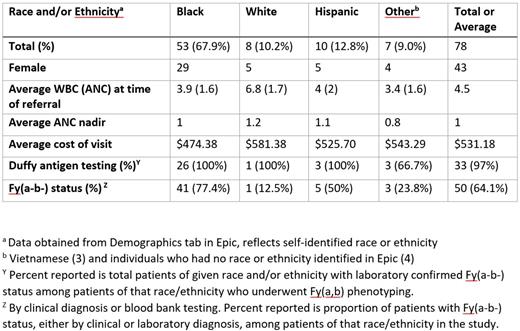Abstract
Typical neutrophil count with Fy(a-b-) status, known variously as Duffy null phenotype or Benign Ethnic Neutropenia, causes asymptomatic neutropenia without clinical sequelae.[i][ii] Fy(a-b-) phenotype is correlated to homozygosity of a single nucleotide polymorphism in the promoter region of atypical chemokine receptor 1 (ACKR1; formerly known as DARC), a decoy chemokine receptor, and may protect against malaria infection.[iii][iv] This genotype is enriched in malaria-endemic regions.[v] 25% to 50% of people of African ancestry in the United States are thought to have Fy(a-b-) status and are often erroneously identified as having pathologically low neutrophil counts.
We performed a retrospective chart review of new neutropenia referrals to Hematology Clinic at Boston Medical Center (BMC) to evaluate diagnostic patterns for typical neutrophil count with Fy(a-b-) status. Overall, 103 new referrals for evaluation of neutropenia were made to BMC Hematology Clinic from 1/2020 to 2/2022, of which 78 were included for further analysis. Demographic and laboratory data are summarized in the accompanying Table. Typical neutrophil count with Fy(a-b-) status was identified as the primary etiology for neutropenia in 64.1% (50 of 78 referrals), of which 41 (82%) identified as African American or Black or were born in an African or Caribbean country. Of patients suspected of having Duffy null phenotype, 66% (33 of 50 patients) underwent confirmatory blood bank testing, and 97% (32 of 33) of these patients were found to have Fy(a-b-) status. Average cost of laboratory visit was calculated for each new referral using the Outpatient Price Transparency Tool from BMC Billing Department, which is based on chargemaster prices for the hospital. Patients with typical neutrophil count with Fy(a-b-) status on average had lower, but not negligible, cost of workup ($363.82 vs $689.46; p<.005 by unpaired student's T test assuming unequal variance) and were statistically less likely to have a follow up appointment (p=0.039 by unpaired student's T test assuming unequal variance) compared to those without.
Though this phenotype reflects normal variation of white cell count in non-White populations, it is a "...label that illustrates how common phenotypes seen in non-White individuals continue to be considered nonstandard in the medical community." Workup of referrals that have typical neutrophil count with Fy(a-b-) status is not currently recommended, unless they have a change in their baseline white cell count or new, atypical features concerning for a secondary etiology.[vi] In our study, asymptomatic referrals were the majority and represent an unnecessary cost burden on an overtaxed healthcare system. Fy(a,b) antigen testing provides a low-cost alternative to hematology referral for confirmation of Fy(a-b-) status for patients or providers who require reassurance. Expanded use of serological Fy(a,b) antigen testing by primary care providers for patients with ancestry from malaria-endemic regions and chronic, asymptomatic neutropenia could reduce cost of care and referrals to Hematology clinic.
[i] Ortiz MV, Meier ER, Hsieh MM. Identification and Clinical Characterization of Children With Benign Ethnic Neutropenia. J Pediatr Hematol Oncol. 2016 Apr;38(3):e140-3. doi: 10.1097/MPH.0000000000000528. PMID: 26925714; PMCID: PMC5102334.
[ii] Merz LE, Achebe M. When non-Whiteness becomes a condition. Blood. 2021 Jan 7;137(1):13-15. doi: 10.1182/blood.2020008600. PMID: 33181819.
[iii] Reich D et al. Reduced neutrophil count in people of African descent is due to a regulatory variant in the Duffy antigen receptor for chemokines gene. PLoS Genet. 2009 Jan;5(1):e1000360. doi: 10.1371/journal.pgen.1000360. Epub 2009 Jan 30. PMID: 19180233; PMCID: PMC2628742.
[iv] Miller LH, Mason SJ, Clyde DF, McGinniss MH. The resistance factor to Plasmodium vivax in blacks. The Duffy-blood-group genotype, FyFy. N Engl J Med. 1976 Aug 5;295(6):302-4. doi: 10.1056/NEJM197608052950602. PMID: 778616.
[v] Haddy TB, Rana SR, Castro O. Benign ethnic neutropenia: what is a normal absolute neutrophil count? J Lab Clin Med. 1999 Jan;133(1):15-22. doi: 10.1053/lc.1999.v133.a94931. PMID: 10385477.
[vi] Gibson C, Berliner N. How we evaluate and treat neutropenia in adults. Blood (2014) 124 (8): 1251-1258. https://doi.org/10.1182/blood-2014-02-482612
Disclosures
Sloan:Abbvie: Consultancy; Nuvectis: Consultancy; Stemline: Consultancy.
Author notes
Asterisk with author names denotes non-ASH members.


This feature is available to Subscribers Only
Sign In or Create an Account Close Modal